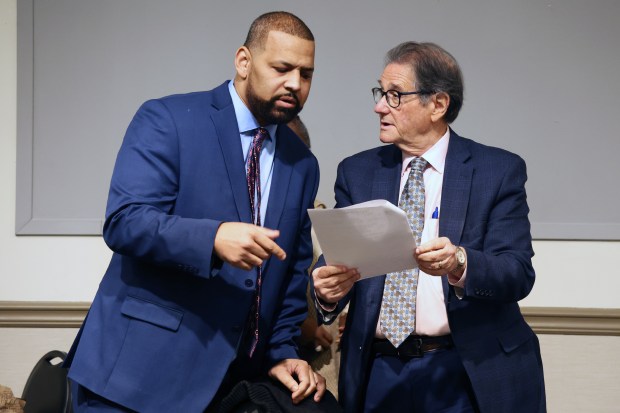While NASCAR says it is committed to “the historic role” of combustion engines in its races, on Saturday it unveiled a new all-electric vehicle at the Chicago Street Race.
Functionally, it takes after some of its other race cars. But it looks different, and it sounds different. Without a roaring engine, its squealing brakes and screeching tires make the most noise over the almost imperceptible hum of its electric battery.
“We want to be in the driver’s seat as these changes are happening, as the market is evolving,” Riley Nelson, the company’s head of sustainability, told the Tribune. “We are investigating and researching all the different types of technology that exist, and electric is one of them.”
Nelson pointed out that the race cars represent a small percentage of the company’s overall carbon footprint. Calculations shared by Argonne National Laboratory scientist Michael Wang for a 2023 Tribune story showed the emissions of 40 NASCAR cars in one weekend would be equivalent to those of five to six passenger cars in a year.
Annual carbon measurements have guided other shorter-term priorities at NASCAR, like improving waste diversion, increasing on-site EV charging stations and, in the next four years, transitioning to the exclusive use of renewable electricity at NASCAR’s racetracks and facilities.
The EV prototype is part of a collaboration with ABB, a multinational electrification and automation company that has been the title sponsor of the electric racing series FIA Formula E World Championship since 2018. The Formula E’s latest model has a top speed of 200 mph.
“We thought that this would make a great opportunity to extend that legacy in the United States,” said Chris Shigas, head of U.S. communications for ABB, a founding partner in the motorsport organization’s sustainability strategy, which includes near-term and long-term initiatives to achieve net-zero emissions.
A spokesperson told the Tribune last year that the company had no concrete plans for an EV-only racing series, something Nelson reiterated Sunday.
“At this point, nothing’s off the table. But there are no immediate plans for an electric series for the car that was unveiled yesterday,” she said. “The EV prototype was really meant to be a showcase of … this exciting new technology.”
Shigas shared a similar sentiment, calling the prototype a metaphor.
“It makes a perfect platform for us to have broad conversations,” he said. “The energy transition isn’t just for some people. It’s for everyone. It’s important to have these conversations about energy in the United States, and how we use it.”
Such conversations, he said, could inspire future generations of electrical and mechanical engineers from transportation to construction “because the demand is here and demand is not going away.”
The organizations said they hope electric innovation can help meet the need for better public access to electric vehicle chargers, an issue in Illinois and across the country, to improve user experiences for owners — and also increase interest among would-be buyers.
“That was really a key part of the conversation leading this partnership,” Nelson said. “Of the 15 racetracks that NASCAR owns, most of them are in rural areas, but also major thoroughfares. Take Talladega in Alabama, it’s right off (State Route) 77 between two highways. … So that’s where we see opportunity, being track operators and owners, to help scale the EV charging network across the country.”
NASCAR engineers collaborated with Chevrolet, Ford and Toyota on the design, culminating in a track-tested stock car with a battery capacity of 78 kilowatt hours that can produce up to 1,000 kilowatts, and with three motors that supply power directly to the four tires.
As with other hybrid and electric racing vehicles, the prototype has a regenerative braking feature — ideal for short tracks and street courses — that transfers energy from the wheels to the battery and converts it into electrical power.
“It’s certainly an impressive piece of technology, right?” Shigas said. “At the front end of this partnership, we’re exploring together what the future of electric racing would look like, and we’ll see where it goes.”





